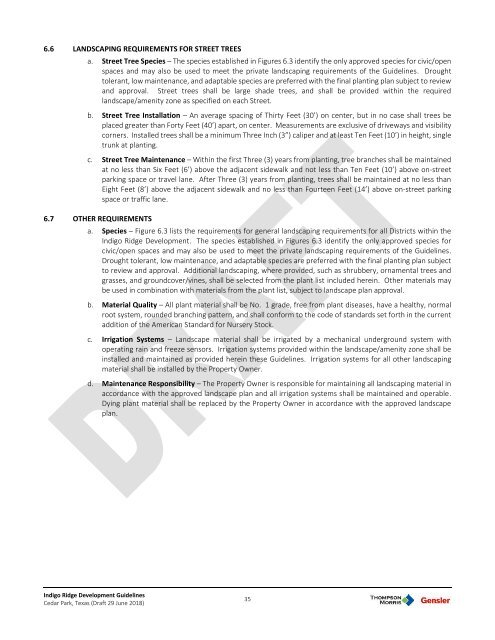2018 06 29 Indigo Ridge Guidelines Draft 01
You also want an ePaper? Increase the reach of your titles
YUMPU automatically turns print PDFs into web optimized ePapers that Google loves.
6.6 LANDSCAPING REQUIREMENTS FOR STREET TREES<br />
a. Street Tree Species – The species established in Figures 6.3 identify the only approved species for civic/open<br />
spaces and may also be used to meet the private landscaping requirements of the <strong>Guidelines</strong>. Drought<br />
tolerant, low maintenance, and adaptable species are preferred with the final planting plan subject to review<br />
and approval. Street trees shall be large shade trees, and shall be provided within the required<br />
landscape/amenity zone as specified on each Street.<br />
b. Street Tree Installation – An average spacing of Thirty Feet (30’) on center, but in no case shall trees be<br />
placed greater than Forty Feet (40’) apart, on center. Measurements are exclusive of driveways and visibility<br />
corners. Installed trees shall be a minimum Three Inch (3”) caliper and at least Ten Feet (10’) in height, single<br />
trunk at planting.<br />
c. Street Tree Maintenance – Within the first Three (3) years from planting, tree branches shall be maintained<br />
at no less than Six Feet (6’) above the adjacent sidewalk and not less than Ten Feet (10’) above on-street<br />
parking space or travel lane. After Three (3) years from planting, trees shall be maintained at no less than<br />
Eight Feet (8’) above the adjacent sidewalk and no less than Fourteen Feet (14’) above on-street parking<br />
space or traffic lane.<br />
6.7 OTHER REQUIREMENTS<br />
a. Species – Figure 6.3 lists the requirements for general landscaping requirements for all Districts within the<br />
<strong>Indigo</strong> <strong>Ridge</strong> Development. The species established in Figures 6.3 identify the only approved species for<br />
civic/open spaces and may also be used to meet the private landscaping requirements of the <strong>Guidelines</strong>.<br />
Drought tolerant, low maintenance, and adaptable species are preferred with the final planting plan subject<br />
to review and approval. Additional landscaping, where provided, such as shrubbery, ornamental trees and<br />
grasses, and groundcover/vines, shall be selected from the plant list included herein. Other materials may<br />
be used in combination with materials from the plant list, subject to landscape plan approval.<br />
b. Material Quality – All plant material shall be No. 1 grade, free from plant diseases, have a healthy, normal<br />
root system, rounded branching pattern, and shall conform to the code of standards set forth in the current<br />
addition of the American Standard for Nursery Stock.<br />
c. Irrigation Systems – Landscape material shall be irrigated by a mechanical underground system with<br />
operating rain and freeze sensors. Irrigation systems provided within the landscape/amenity zone shall be<br />
installed and maintained as provided herein these <strong>Guidelines</strong>. Irrigation systems for all other landscaping<br />
material shall be installed by the Property Owner.<br />
d. Maintenance Responsibility – The Property Owner is responsible for maintaining all landscaping material in<br />
accordance with the approved landscape plan and all irrigation systems shall be maintained and operable.<br />
Dying plant material shall be replaced by the Property Owner in accordance with the approved landscape<br />
plan.<br />
<strong>Indigo</strong> <strong>Ridge</strong> Development <strong>Guidelines</strong><br />
Cedar Park, Texas (<strong>Draft</strong> <strong>29</strong> June <strong>2<strong>01</strong>8</strong>)<br />
35


